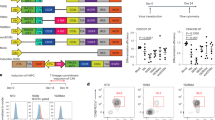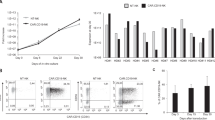Abstract
Differentiation of genetically modified CD34+ hematopoietic stem cells into dendritic cells (DCs) will contribute to the development of immunotherapeutic anticancer protocols. Retroviral vectors that have been used for the transduction of CD34+ cells face the problem of gene silencing when integrated into the genome of repopulating stem cells. We reasoned that a high copy number of retroviral DNA sequences might overcome silencing of transgene expression during expansion and differentiation of progenitor cells into functional DCs. To prove this, we utilized a retroviral vector with bicistronic expression of the melanoma-associated antigen tyrosinase and the enhanced green fluorescent protein (EGFP). Human cord blood CD34+ cells were transduced with vesicular stomatitis virus G-protein (VSV-G) pseudotyped Moloney murine leukemia virus (MoMuLV) particles using 100–150 multiplicity of infection. During expansion of transduced cells with immature phenotype, transgene expression was strongly silenced, but upon differentiation into mature DCs, residual transgene expression was retained. Intracellular processing of the provirally expressed tyrosinase was tested in a chromium release assay utilizing a cytotoxic T cell clone specific for a HLA-A*0201-restricted tyrosinase peptide. We suggest that retroviral transduction of tumor-associated antigens in hematopoietic progenitor cells and subsequent differentiation into DCs is a suitable basis for the development of potent anti-tumor vaccines.
This is a preview of subscription content, access via your institution
Access options
Subscribe to this journal
Receive 12 print issues and online access
$259.00 per year
only $21.58 per issue
Buy this article
- Purchase on Springer Link
- Instant access to full article PDF
Prices may be subject to local taxes which are calculated during checkout







Similar content being viewed by others
References
Movassagh M et al. High level of retrovirus-mediated gene transfer into dendritic cells derived from cord blood and mobilized peripheral blood CD34+ cells Hum Gene Ther 1999 10: 175–187
Movassagh M et al. High-level gene transfer to cord blood progenitors using gibbon ape leukemia virus pseudotype retroviral vectors and an improved clinically applicable protocol Hum Gene Ther 1998 9: 225–234
Evans JT et al. Pre-clinical evaluation of an in vitro selection protocol for the enrichment of transduced CD34+ cell-derived human dendritic cells Gene Therapy 2001 8: 1427–1435
Evans JT, Cravens P, Lipsky EP, Garcia JV . Differentiation and expansion of lentivirus vector-marked dendritic cells derived from human CD34+ cells Hum Gene Ther 2000 11: 2483–2492
Benchimol S et al. Carcinoembryonic antigen, a human tumor marker, functions as an intercellular adhesion molecule Cell 1989 57: 327–334
Chen D, Shou C . Molecular cloning of a tumor-associated antigen recognized by monoclonal antibody 3H11 Biochem Biophys Res Commun 2001 280: 99–103
Brichard V et al. The tyrosinase gene codes for an antigen recognized by autologous cytolytic T lymphocytes on HLA-A2 melanomas J Exp Med 1993 178: 489–495
Bakker AB et al. Melanocyte lineage-specific antigen gp100 is recognized by melanoma-derived tumor-infiltrating lymphocytes J Exp Med 1994 179: 1005–1009
Coulie PG et al. A new gene coding for a differentiation antigen recognized by autologous cytolytic T lymphocytes on HLA-A2 melanomas J Exp Med 1994 180: 35–42
Ambrosini G, Adida C, Altieri DC . A novel anti-apoptosis gene, survivin, expressed in cancer and lymphoma Nat Med 1997 3: 917–921
Inaba K, Metlay JP, Crowley MT, Steinman RM . Dendritic cells pulsed with protein antigens in vitro can prime antigen-specific, MHC-restricted T cells in situ J Exp Med 1990 172: 631–640
Porgador A, Gilboa E . Bone marrow-generated dendritic cells pulsed with a class I-restricted peptide are potent inducers of cytotoxic T lymphocytes J Exp Med 1995 182: 255–260
Schmitz M et al. Generation of survivin-specific CD8+ T effector cells by dendritic cells pulsed with protein or selected peptides Cancer Res 2000 60: 4845–4849
Boczkowski D, Nair SK, Snyder D, Gilboa E . Dendritic cells pulsed with RNA are potent antigen-presenting cells in vitro and in vivo J Exp Med 1996 184: 465–472
Gong J et al. Induction of antigen-specific antitumor immunity with adenovirus-transduced dendritic cells Gene Therapy 1997 10: 1023–1028
Meyer zum Büschenfelde C et al. Generation of tumor-reactive CTL against the tumor-associated antigen HER2 using retrovirally transduced dendritic cells derived from CD34+ hematopoetic progenitor cells J Immunol 2000 165: 4133–4140
Reeves ME et al. Retroviral transduction of human dendritic cells with a tumor-associated antigen gene Cancer Res 1996 56: 5672–5677
Drexler I et al. Modified vaccinia virus Ankara for delivery of human tyrosinase as melanoma-associated antigen: induction of tyrosinase- and melanoma-specific human leukocyte antigen A*0201-restricted cytotoxic T cells in vitro and in vivo Cancer Res 1999 59: 4955–4963
Butterfield LH et al. Generation of melanoma-specific cytotoxic T lymphocytes by dendritic cells transduced with a MART-1 adenovirus J Immunol 1998 161: 5607–5613
Zitvogel L et al. Eradication of established murine tumors using a novel cell-free vaccine: dendritic cell-derived exosomes Nat Med 1998 5: 594–600
Gong J, Chen D, Kashiwaba M, Kufe D . Induction of antitumor activity by immunization with fusions of dendritic and carcinoma cells Nat Med 1997 5: 558–561
Rasmussen R . Quantification on the LightCycler Meurer S, Wittwer C, Nakagawara K (eds); Rapid Cycle Real-Time PCR: Methods and Application Springer 2001 pp 21–34
Visseren MJ et al. CTL specific for the tyrosinase autoantigen can be induced from healthy donor blood to lyse melanoma cells J Immunol 1995 154: 3991–3998
Caux C, Dezutter-Dambuyant C, Schmitt D, Banchereau J . GM-CSF and TNF-alpha cooperate in the generation of dendritic Langerhans cells Nature 1992 360: 258–261
Caux C et al. CD34+ hematopoietic progenitors from human cord blood differentiate along two independent dendritic cell pathways in response to GM-CSF + TNF alpha J Exp Med 1996 184: 695–706
Strunk D et al. Generation of human dendritic cells/Langerhans cells from circulating CD34+ hematopoietic progenitor cells Blood 1996 87: 1292–1302
Klug CA, Cheshier S, Weissman IL . Inactivation of a GFP retrovirus occurs at multiple levels in long-term repopulating stem cells and their differentiated progeny Blood 2000 96: 894–901
Cherry SR et al. Retroviral expression in embryonic stem cells and hematopoietic stem cells Mol Cell Biol 2000 20: 7419–7426
Lorincz MC, Schubeler D, Groudine M . Methylation-mediated proviral silencing is associated with MeCP2 recruitment and localized histone H3 deacetylation Mol Cell Biol 2001 21: 7913–7922
Pannell D et al. Retrovirus vector silencing is de novo methylase independent and marked by a repressive histone code EMBO J 2000 19: 5884–5894
Lindemann C et al. Down-regulation of retroviral transgene expression during differentiation of progenitor-derived dendritic cells Exp Hematol 2002 30: 150–157
Li Z et al. Murine leukemia induced by retroviral gene marking Science 2002 296: 497
Pawliuk R et al. Correction of sickle cell disease in transgenic mouse models by gene therapy Science 2001 294: 2368–2371
Miyoshi H et al. Transduction of human CD34+ cells that mediate long-term engraftment of NOD/SCID mice by HIV vectors Science 1999 283: 682–686
Berberich-Siebelt S et al. C/EBPß enhances IL-4 but impairs IL-2 and IFN-g induction in T cells Eur J Immunol 2000 30: 2576–2585
Dinev D et al. Extracellular signal regulated kinase 5 (ERK5) is required for the differentiation of muscle cells EMBO Rep 2001 9: 829–934
Soneoka Y et al. A transient three-plasmid expression system for the production of high titer retroviral vectors Nucleic Acids Res 1995 23: 628–633
DuBridge RB et al. Analysis of mutation in human cells by using an Epstein-Barr virus shuttle system Mol Cell Biol 1987 7: 379–387
Lapointe R et al. Human dendritic cells require multiple activation signals for the efficient generation of tumor antigen-specific T lymphocytes Eur J Immunol 2000 11: 3291–3298
Feinberg AP, Vogelstein B . A technique for radiolabelling DNA restriction endonuclease fragments to high specifc activity Anal Biochem 1979 132: 6–13
Acknowledgements
This work was supported by a grant of the Ministry of Environment and Agriculture (Az. 56-8811.61/71), the State of Saxony, Germany, to AT and EPR. We thank S Heinicke and B Utess for excellent technical assistance. We are grateful to Dr PI Schrier, Department of Clinical Oncology, Leiden, and to Prof Dr CJ Melief, Department of Immunohematology and Blood Transfusion, Tumor Immunology Laboratory, Leiden, The Netherlands, for providing the tyrosinase specific T cell clone TyrF8.
Author information
Authors and Affiliations
Rights and permissions
About this article
Cite this article
Temme, A., Morgenroth, A., Schmitz, M. et al. Efficient transduction and long-term retroviral expression of the melanoma-associated tumor antigen tyrosinase in CD34+ cord blood-derived dendritic cells. Gene Ther 9, 1551–1560 (2002). https://doi.org/10.1038/sj.gt.3301821
Received:
Accepted:
Published:
Issue Date:
DOI: https://doi.org/10.1038/sj.gt.3301821
Keywords
This article is cited by
-
Dendritic cell-directed lentivector vaccine induces antigen-specific immune responses against murine melanoma
Cancer Gene Therapy (2011)
-
Engineered lentivector targeting of dendritic cells for in vivo immunization
Nature Biotechnology (2008)
-
A phase I vaccination study with tyrosinase in patients with stage II melanoma using recombinant modified vaccinia virus Ankara (MVA-hTyr)
Cancer Immunology, Immunotherapy (2005)



